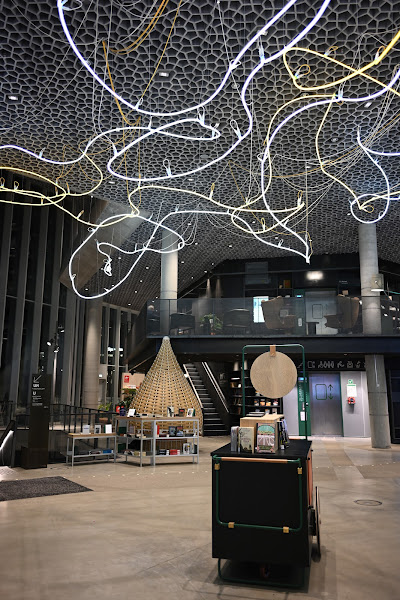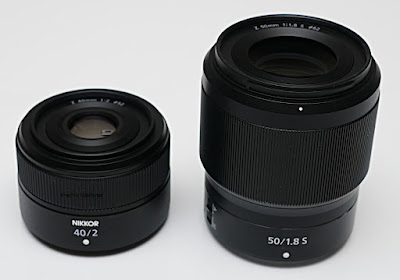Nikon Z 28mm f/2.8 review (and comparison with 40mm f/2)
The pair of compact and reasonably priced primes, 28mm f/2.8 and 40mm f/2, were met with anticipation when launched: Finally some lenses for the Z system that were not only optimized for performance, but also for size and price. Having smaller and less expensive primes will certainly help the system to succeed.
The 28mm lens was available first, but then only with some retro decorations in a kit with the Nikon Z fc retro styled camera. The 40mm lens was available for individual purchase first, then followed by the non-retro styled 28mm lens. Both seen below:
Nikkor Z 28mm f/2.8 and Nikkor Z 40mm f/2
I have already reviewed the Nikkor Z 40mm f/2 lens. Now that I have both, however, it makes sense to compare them. Which one of them should you get?
| Lens | Nikon Z 28mm f/2.8 | Nikon Z 40mm f/2 |
| Number of diaphragm blades | 7 | 9 |
| Lens elements/groups | 9/8 | 6/4 |
| Minimum focus distance | 0.19m | 0.29m |
| Weight | 155g | 170g |
| Diameter | 70mm | 70mm |
| Length | 43mm | 46mm |
| Filter thread | 52mm | 52mm |
Perhaps contrary to the expectation, then 28mm lens has the more complex optical formula, with 9 lens elements. Both have two aspherical elements, though, shown in blue, and the 40mm lens has the largest apspherical element, the rear element that projects into the image sensor:
Looking at the 28mm lens, you might think that the front lens diameter is surprisingly small for an f/2.8 lens. However, the math does check out: The minimum opening would correspond to the focal length divided by the aperture, i.e., 28mm/2.8, which gives 10mm. And the front lens element is probably just above 10mm in diameter. This calculation also seems ok for the 40mm lens.
You might be concerned that f/2.8 is too small for a prime lens. With the current low light (high ISO) capabilities of cameras, though, I don't think this is an issue with most use. I think that f/2.8 was a good choice for the 28mm lens. Had they made it f/2, it would have been twice as heavy and US$200 more.
However, it is important that the lens is actually usable at f/2.8. If you need to stop down to get acceptable image quality, then the point of the lens largely expires. So in this review, I aim to check if the lens us usable wide open.
Physical construction
Both lenses are basically the same form factor, beyond the different optics inside. The lens barrel seems to be made from a plastic like material with a fine, matte crinkle finish, which is somewhat grippy. I actually prefer this to the smooth finish of the S line lenses, which is slippery.
There is a focus ring which occupies about half of the lens barrel, and it has a rubbery, ribbed material which is easy to operate. It feels nicely dampened.
From the rear, we can see the "elephant in the room", the nylon lens bayonet mounts. Some would be disappointed that the lens mount is not steel. However, I think this is a good compromise: It keeps the weight and the price down, and it is more than adequate for such a small and light lens anyway.
The lenses don't have any rubber seal around the mount. So there is no environmental seal. Probably not a big issue: It is not like there is an opening here. But the safety is not as good as with S-line lenses.
The lenses don't have AF/Manual switches, to save costs. This is also fine in my opinion. You rarely need this switch with these lenses. And if you do, you can operate it from the camera menu.
Mounted on the Nikon Z7, we can appreciate the small size of the 28mm lens:
Is the lens really that small, tough? Here I have laid out other 28mm equivalent lenses for other, smaller, imaging formats:
From left to right, we have the Nikon 28mm f/2.8 (full-frame, no crop factor), Sigma 19mm f/2.8 (crop factor 1.5), Lumix G 14mm f/2.5 (crop factor 2) and finally, in glorious red, Nikon 1 10mm f/2.8 (crop factor 2.7). You can verify that all of them have the same equivalent field of view by multiplying the focal length with the crop factor.
The lens does not come with a hood, and there is no bayonet mount for a hood on the front. I like to have at least a small hood on my lenses, so as an alternative solution, I have been using a 52mm to 49mm step down ring as a miniature hood. Keep in mind that you'll also need a replacement front lens cap as well.
Image quality
First off, there is a difference in focal length: 28mm vs 40mm. Most people understand what this means already, but just to be clear, the 28mm lens has a wider field of view, and would normally be called a "wide angle lens". 40mm is more of an odd focal length, shorter than a "normal lens". Both these images were taken from the same point, illustrating the difference in field of view:
| Lens | Nikon Z 28mm f/2.8 | Nikon Z 40mm f/2 |
How does the image quality compare? To examine it, I have take pictures of the same scenes with both lenses, and moved my tripod a bit back with the 40mm lens for the same approximate field of view.
First a series of images taken at a moderate focus distance. The focus was set on the left tree in the foreground, although the right tree is at approx the same distance:
| Lens | Nikon Z 28mm f/2.8 @ f/2.8 | Nikon Z 40mm f/2 @ f/2 |
Here are 100% crops from the left tree, about the middle of the picture frame vertically:
And from the very extreme top left corner of the images. Unfortunately. the pictures are different in this area due to the different fields of view:
Here is a series of images taken at a infinity focus distance:
| Lens | Nikon Z 28mm f/2.8 @ f/2.8 | Nikon Z 40mm f/2 @ f/2 |
In the centre, both lenses perform very well already wide open. But this series of 100% crops from the top right corner show how they are not doing well wide open, but benefit from stopping down:
We see that both lenses show significant vignetting (dark corners) wide open, the 28mm lens more so than the 40mm lens. Stopping down at least one stop helps this quite a lot.
Here is another series of images. Again, I moved the tripod back with the 40mm lens to get approximately the same field of view:
| Lens | Nikon Z 28mm f/2.8 @ f/2.8 | Nikon Z 40mm f/2 @ f/2 |
These 100% crops from the centre area shows that both lenses perform quite well already wide open:
In general, the image quality is very good in the centre area with both lenses, also wide open. With this in mind, the lenses should pair well with APS-C sensor size cameras, like the Nikon Z fc.
Bokeh
The term "bokeh" refers to the rendering of out of focus areas. Ideally, it should be smooth and non-distracting. To examine this, I have taken a series of images with the 28mm lens, with a close focus distance and some background highlights:
| 28mm @ f/2.8 |
| 28mm @ f/4 |
| 28mm @ f/5.6 |
In the corner, we see that there is some cateye bokeh (cropped out of focus highlight discs) at the largest aperture, which is a bit distracting. This goes away when stopping down. Otherwise, the bokeh looks fine.
Here is another example without the highlights, where I have focused as close as possible and used the lens wide open at f/2.8:
The bokeh looks smooth and effective all over in this case.
Conclusion
Based on the test images I have taken, it is clear that these are not prestigious lenses designed for the best image quality: Rather, they are designed to be small and inexpensive. So you shouldn't expect as good results as with the S-line prime lenses, e.g., the 35mm f/1.8 S.
If you are taking pictures where the image quality in the corners is not crucial, for example for environmental portraits or pictures of groups of people, you can use these lenses wide open or stopped down a bit. If, on the other hand, you are taking landscape photos where the sharpness all over is important, you need to stop down to at least f/5.6, or choose a higher quality lens.
So which lens should you choose? If you already have an affinity for wide angle prime lenses, the choice is clear: Go for the Nikkor Z 28mm f/2.8.
On the other hand, if you are looking to buy only one small prime lens for compactness, I would say that the Nikkor Z 40mm f/2 is the better choice: It is faster (larger maximum aperture), and the 40mm focal length is a nice compromise between a classic wide angle lens and a classic prime lens, making it quite useful. It also seems to have a small edge when it comes to the optical quality, although they are fairly similar in this way.
Example images
Click to see larger versions:
f/2.8, ISO 640:
f/2.8, ISO 900:
f/3.5, ISO 1000:
f/2.8, ISO 800:



























Comments
Post a Comment